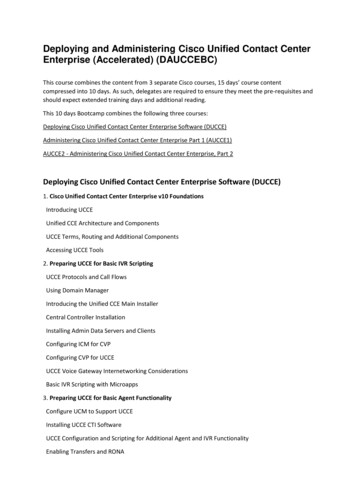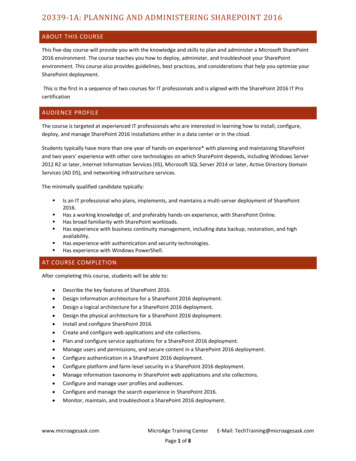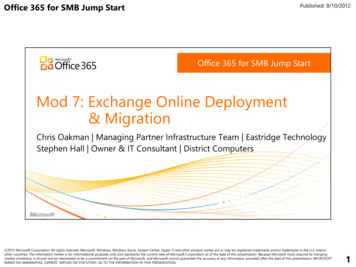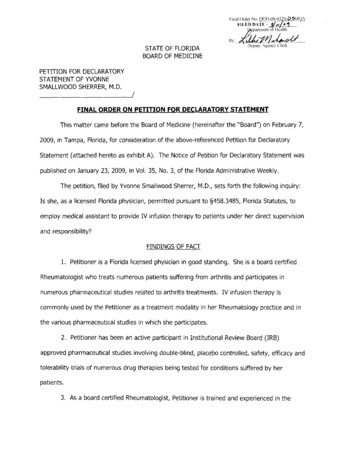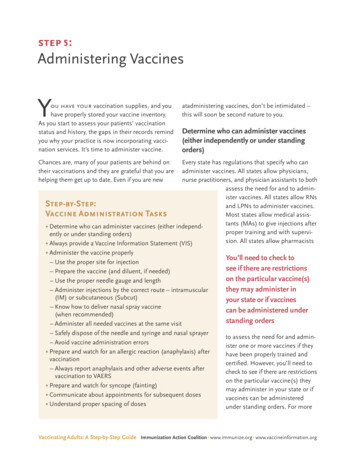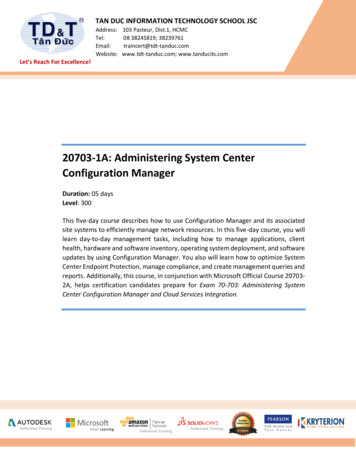
Transcription
TAN DUC INFORMATION TECHNOLOGY SCHOOL JSCAddress:Tel:Email:Website:103 Pasteur, Dist.1, HCMC08 38245819; ; www.tanducits.comLet’s Reach For Excellence!20703-1A: Administering System CenterConfiguration ManagerDuration: 05 daysLevel: 300This five-day course describes how to use Configuration Manager and its associatedsite systems to efficiently manage network resources. In this five-day course, you willlearn day-to-day management tasks, including how to manage applications, clienthealth, hardware and software inventory, operating system deployment, and softwareupdates by using Configuration Manager. You also will learn how to optimize SystemCenter Endpoint Protection, manage compliance, and create management queries andreports. Additionally, this course, in conjunction with Microsoft Official Course 207032A, helps certification candidates prepare for Exam 70-703: Administering SystemCenter Configuration Manager and Cloud Services Integration.Authorized TrainingSilver LearningAuthorized TrainingAuthorized Training
20703-1A: Administering System Center Configuration ManagerAUDIENCEThis course is for experienced information technology (IT) professionals, typically described asEnterprise Desktop Administrators (EDAs). These EDAs deploy, manage, and maintain PCs,devices, and applications across medium, large, and enterprise organizations. A significantportion of this audience uses, or intends to use, the latest release of Configuration Manager tomanage and deploy PCs, devices, and applicationsPREREQUISITESBefore attending this course, students must have a working knowledge at the systemadministrator level of:Networking fundamentals, including common networking protocols, topologies,hardware, media, routing, switching, and addressing. Active Directory Domain Services (AD DS) principles and fundamentals of AD DSmanagement. Installation, configuration, and troubleshooting for Windows-based personal computers. Basic concepts of public key infrastructure (PKI) security. Basic understanding of scripting and Windows PowerShell syntax. Basic understanding of Windows Server roles and services. Basic understanding of the configuration options for iOS, Android, and Windows Mobiledevice platforms.Students who attend this training can meet the prerequisites by attending the followingcourses or by obtaining equivalent knowledge and skills through hands-on activities: Course 20697-1: Installing and Configuring Windows 10 Course 20697-2: Deploying and Managing Windows 10 Using Enterprise Services Course 20411: Administering Windows Server 2012 AT COURSE COMPLETIONAfter completing this course, students will be able to: Describe the features Configuration Manager and Intune include, and explain howyou can use these features to manage PCs and mobile devices in an enterpriseenvironment.Analyze data by using queries and reports.Prepare a management infrastructure, including configuring boundaries, boundarygroups, and resource discovery, and integrating mobile-device management withMicrosoft Exchange Server.Deploy and manage the Configuration Manager client.Configure, manage, and monitor hardware and software inventory, and use AssetIntelligence and software metering.Identify and configure the most appropriate method to distribute and managecontent used for deployments.Distribute, deploy, and monitor applications for managed users and systems.Maintain software updates for PCs that Configuration Manager manages.[1]
20703-1A: Administering System Center Configuration Manager Implement Endpoint Protection for managed PCs.Manage configuration items, baselines, and profiles to assess and configurecompliance settings and data access for users and devices.Configure an operating-system deployment strategy by using Configuration Manager.Manage and maintain a Configuration Manager site.COURSE OUTLINEModule 1: Managing computers and mobile devices in the enterpriseThis module describes the features of Configuration Manager that you can use to performcomplex management tasks, including the following tasks: Hardware and software inventory. Application management. Operating system deployment. Settings management. Software update management. Remote client troubleshooting. Protection from malware.Lessons Overview of systems management by using enterprise management solutionsOverview of the Configuration Manager architectureOverview of the Configuration Manager administrative toolsTools for monitoring and troubleshooting a Configuration Manager siteLab: Exploring the Configuration Manager tools Searching in the Configuration Manager consoleUsing Windows PowerShell with Configuration ManagerUsing Configuration Manager Service Manager to manage componentsMonitoring site and component statusReviewing log files by using the Configuration Manager Trace toolExplain how to use Configuration Manager to address the challenges of managingsystems and users in today’s enterprise.Describe the Configuration Manager architecture.Describe the management tools that you use to perform administrative functions forConfiguration Manager.Describe the tools that you use to monitor and troubleshoot a Configuration Managersite.Module 2: Analyzing data using queries and reportsThe Microsoft System Center Configuration Manager database stores a large amount of dataabout the resources in your environment. You might not always want to perform all managementtasks on all resources simultaneously. Therefore, to help you locate devices or user objects inyour environment that meet specific criteria, you can create queries. You then can use these[2]
20703-1A: Administering System Center Configuration Managerqueries to create collections or to find additional information about specific resources. Thismodule describes queries and methods of creating and running them. In addition to queries, youcan run reports to view various types of information related to your Configuration Managerenvironment. To run Configuration Manager reports, you must install and configure a reportingservices point, which this module details.Lessons Introduction to queries Configuring Microsoft SQL Server Reporting Services (SSRS)Lab: Creating and running queries Configuring boundaries and resource discovery Creating data queries Creating subselect queries Creating status message queriesLab: Configuring SSRS Configuring a reporting services point Creating a report by using Report Builder Create and configure data and status message queries. Configure and manage SSRS and the reporting services point.Module 3: Preparing the management infrastructure to support PCs and mobile devicesThis module explains how to prepare the management infrastructure, including configuringboundaries, boundary groups, and resource discovery. Additionally, it describes howConfiguration Manager interacts with the Microsoft Exchange Server environment to discoverand manage mobile devices.Lessons Configuring site boundaries and boundary groups Configuring resource discovery Configuring the Exchange Server Connector for mobile device management Configuring user and device collectionsLab: Configuring boundaries and resource discovery Configuring boundaries, boundary groups, and fallback relationships Configuring Active Directory discovery methodsLab: Configuring user and device collections Creating a device collection Creating a user collection Configuring a maintenance window Configure boundaries and boundary groups. Configure resource discovery. Configure the Exchange Server connector mobile device management. Organize resources using device and user collections.Module 4: Deploying and managing clients[3]
20703-1A: Administering System Center Configuration ManagerThis module explains the supported operating systems and devices, the software requirements,and the different methods for installing the Configuration Manager client. This module alsodescribes some of the default and custom client settings that you can configure. After installingthe client software, you can configure the client settings to perform routine management tasks.Lessons Overview of the Configuration Manager client Deploying the Configuration Manager client Configuring and monitoring client status Managing client settings in Configuration ManagerLab: Deploying the Microsoft System Center Configuration Manager client software Preparing the site for client installation Deploying the Configuration Manager client software by using client push installationLab: Configuring and monitoring client status Configuring and monitoring client health statusLab: Managing client settings Configuring client settings Describe the requirements and considerations for installing the Configuration Managerclient software. Deploy the Configuration Manager client software. Configure and monitor client status. Manage Configuration Manager client settings.Module 5: Managing inventory for PCs and applicationsThis module provides an overview of inventory collection, and explains how you can manage theinformation collected. You also will learn about the process of collecting hardware and softwareinventory, initiating inventory cycles, and initiating and securing inventory collection. Thismodule also covers the use of software metering to monitor program usage, and theconfiguration and management of Asset Intelligence.Lessons Overview of inventory collection Configuring hardware and software inventory Managing inventory collection Configuring software metering Configuring and managing Asset IntelligenceLab: Configuring and managing inventory collection Configuring and managing hardware inventoryLab: Configuring software metering Configuring software metering[4]
20703-1A: Administering System Center Configuration ManagerLab: Configuring and managing Asset Intelligence Preparing the site for Asset Intelligence Configuring Asset Intelligence Monitoring license agreements by using Asset Intelligence Viewing Asset Intelligence reports Describe inventory collection. Configure and collect hardware and software inventory. Manage inventory collection. Configure software metering. Configure Asset Intelligence.Module 6: Distributing and managing content used for deploymentsConfiguration Manager clients obtain content, such as packages, applications, softwareupdates, and even operating system images, from distribution points. Configuration Managerrelies on the distribution point infrastructure to provide content management functionality. Inthis module, you will review the content management features, configure distribution points,and learn how to distribute and monitor content. You also will perform content validation andcontent prestaging.Lessons Preparing the infrastructure for content management Distributing and managing content on distribution pointsLab: Distributing and managing content for deployments Installing a new distribution point Managing content distribution Prepare the infrastructure for content management. Distribute and manage content on distribution points.Module 7: Deploying and managing applicationsIn this module, you will learn about the methods for creating, deploying, and managingapplications with Configuration Manager. You also will learn to use the Software Center and theApplication Catalog to install available applications. You will learn about managing deploymentson unconventional applications. In addition, you will learn to install Windows 10 apps andvirtualized applications.Lessons Overview of application managementCreating applicationsDeploying applicationsManaging applicationsDeploying virtual applications by using System Center Configuration Manager (Optional)Deploying and managing Windows Store appsLab: Creating and deploying applications[5]
20703-1A: Administering System Center Configuration Manager Installing and configuring the Application Catalog rolesCreating applications with requirementsDeploying applicationsLab: Managing application supersedence and removal Managing application supersedence Uninstalling the Excel Viewer applicationLab: Deploying virtual applications by using Configuration Manager (Optional) Configuring support for App-V Deploying virtual applicationsLab: Using Configuration Manager to deploy Windows Store apps Configuring support for sideloading Windows Store apps Configuring a Windows Store app Deploying Windows 10 apps to users Describe the application management features of Configuration Manager. Create applications. Deploy applications. Manage applications. Configure and deploy virtual applications. Configure and deploy Windows Store apps.Module 8: Maintaining software updates for managed PCsThis module explains how to use the software updates feature in Configuration Manager toimplement an end-to-end management process for the complex task of identifying, deploying,and monitoring software updates to your Configuration Manager clients.Lessons The software updates process Preparing a Configuration Manager site for software updates Managing software updates Configuring automatic deployment rules Monitoring and troubleshooting software updatesLab: Configuring the site for software updates Configuring and synchronizing the software update pointLab: Deploying and managing software updates Determining software update compliance Deploying software updates to clients Configuring automatic deployment rules Describe how the software updates feature integrates with Configuration Manager. Prepare the Configuration Manager site for software updates. Manage the evaluation and deployment of software updates.[6]
20703-1A: Administering System Center Configuration Manager Configure automatic deployment rules.Monitor and troubleshoot software updates.Module 9: Implementing Endpoint Protection for managed PCsConfiguration Manager provides a number of security-related features that you can use to helpprotect client computers from malware threats, and to configure specific Windows Firewallsettings for clients. Based on System Center Endpoint Protection (Endpoint Protection)functionality, Endpoint Protection in Configuration Manager supports the deployment,management, and monitoring of antimalware policies and Windows Firewall settings on clientcomputers. This module explains how to use configure Endpoint Protection ConfigurationManager to implement Endpoint Protection and deploy and monitor Endpoint Protectionpolicies.Lessons Overview of Endpoint Protection in Configuration Manager Configuring, deploying, and monitoring Endpoint Protection policiesLab: Implementing Microsoft System Center Endpoint Protection Configuring the System Center Endpoint Protection point and client settings Configuring and deploying Endpoint Protection policies Monitoring Endpoint Protection Configure Endpoint Protection to detect and remediate malware and securityvulnerabilities. Configure, deploy, and manage Endpoint Protection policies.Module 10: Managing compliance and secure data accessMany enterprise organizations require systems, such as servers, laptops, desktop computers,and mobile devices, to meet specific configuration and compliance requirements. Compliancesettings in Configuration Manager can play a key role in identifying existing configurations,discovering systems that have adverse configuration changes, and remediating these settingsautomatically when necessary. Compliance settings also can help control how users manageand access data in the enterprise network environment. For computers that run Windows 8 andnewer operating systems, you can manage data using folder redirection, offline files, androaming profiles. You also can control access to data using remote connection profiles, virtualprivate network (VPN) profiles, Wi-Fi profiles, and certificate profiles. This module describes thecompliance settings that you can manage using Configuration Manager. You will learn to usethese settings to maintain configuration requirements and to provide secure data access toenterprise resources.Lessons Overview of Compliance Settings Configuring compliance settings Viewing compliance results Managing resource and data accessLab: Managing compliance settings Managing configuration items and baselines Viewing compliance settings and reports[7]
20703-1A: Administering System Center Configuration Manager Configuring remediation in compliance settingsUsing compliance information to create collectionsDescribe compliance settings features. Configure compliance settings. View compliance results. Manage resource and data access.Module 11: Managing operating system deploymentYou can use the operating system deployment feature in Configuration Manager to createoperating system images that you can deploy to unmanaged computers and those managed byConfiguration Manager. There are several scenarios in which you can deploy operating systemsby using Configuration Manager, including when you are working with new systems or whenyou are upgrading existing ones. Operating system deployment uses both ConfigurationManager and Windows components to manage and deliver operating system images. You canconfigure settings on a reference computer prior to capturing an image of its operating systemor by using task sequences that Configuration Manager creates after you deploy the image to atarget system. This module explains how to use Configuration Manager to create a strategy foroperating-system deployments. And also, it explains how to manage Windows as a service.Lessons An overview of operating system deployment Preparing a site for operating system deployment Deploying an operating system Managing Windows as a serviceLab: Preparing the site for operating -system deployment Managing the site system roles used to support operating system deployment Managing packages to support operating system deploymentLab: Deploying operating -system images for bare-metal installations Preparing the operating system image Creating a task sequence to deploy an image Deploying an image Describe the terminology, components, and scenarios used to deploy operating systemsby using Configuration Manager. Describe how to prepare a site for operating system deployment. Describe the process used to deploy an operating system image.Module 12: Managing and maintaining a Configuration Manager siteThis module explains how to use manage and maintain a Configuration Manager site. Itdescribes role-based administration, Remote Tools, and the site maintenance tasks that youcan manage by using Configuration Manager. Additionally, it explains how to back up andrecover a Configuration Manager site system.Lessons Configuring role-based administration Configuring Remote Tools Overview of Configuration Manager site maintenance[8]
20703-1A: Administering System Center Configuration Manager Backing up and recovering a Configuration Manager siteLab: Configuring role-based administration Configuring a new scope for Toronto administrators Configuring a new administrative userLab: Configuring Remote Tools Configuring the Remote Tools client settings and permissions Managing desktops by using Remote ControlLab: Maintaining a Configuration Manager site Configuring maintenance tasks in Configuration Manager Configuring the Backup Site Server task Recovering a site from a backup Configure role-based administration. Configure Remote Tools to support client activity. Identify Configuration Manager site Maintenance tasks. Back up and recover a Configuration Manager site.[9]
Reviewing log files by using the Configuration Manager Trace tool Explain how to use Configuration Manager to address the challenges of managing systems and users in today's enterprise. Describe the Configuration Manager architecture. Describe the management tools that you use to perform administrative functions for


